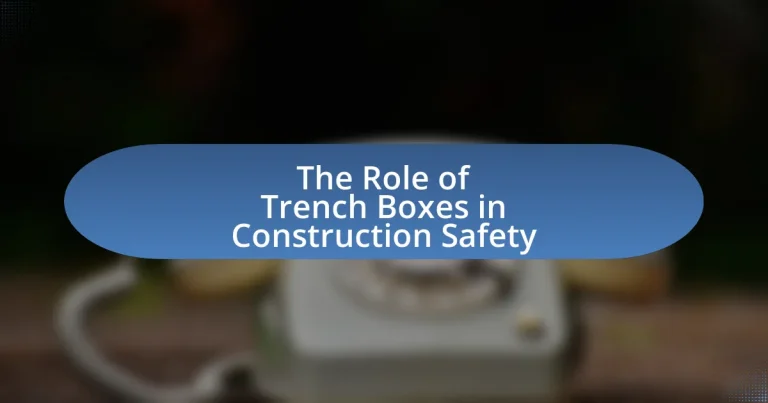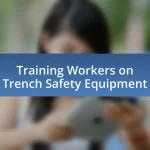Trench boxes, also known as trench shields, are essential protective structures used in excavation sites to prevent soil collapse and safeguard workers from cave-ins. This article outlines the purpose and functionality of trench boxes in enhancing construction safety, detailing their key features, types, and the legal requirements surrounding their use. It also discusses best practices for installation, inspection, and maintenance, as well as the latest innovations in trench box technology that improve safety and compliance with Occupational Safety and Health Administration (OSHA) regulations. By understanding the critical role of trench boxes, construction professionals can significantly reduce the risk of accidents and fatalities associated with trenching operations.

What are Trench Boxes and Their Purpose in Construction Safety?
Trench boxes, also known as trench shields, are protective structures used in excavation sites to prevent soil collapse and protect workers from cave-ins. Their primary purpose in construction safety is to provide a safe working environment by supporting the walls of the trench, thereby reducing the risk of injury or fatality associated with trench-related accidents. According to the Occupational Safety and Health Administration (OSHA), trench collapses can occur within seconds, making the use of trench boxes essential for compliance with safety regulations and for safeguarding workers in deep excavations.
How do Trench Boxes function in protecting workers?
Trench boxes function by providing a protective barrier around workers in excavations, preventing soil collapse and protecting against cave-ins. These engineered structures are designed to support the walls of a trench, ensuring that workers can operate safely within the excavation site. According to the Occupational Safety and Health Administration (OSHA), trench boxes must meet specific safety standards to effectively reduce the risk of injury or fatality from trench-related accidents, which account for a significant number of construction fatalities each year. By using trench boxes, construction sites can significantly enhance worker safety and comply with regulatory requirements.
What are the key features of Trench Boxes that enhance safety?
Trench boxes enhance safety through features such as structural integrity, ease of installation, and compliance with safety regulations. Structural integrity is ensured by using high-strength materials that can withstand soil pressure and prevent collapses, which is critical as trench collapses account for a significant percentage of excavation-related fatalities. Ease of installation allows for quick deployment, minimizing the time workers are exposed to potential hazards. Additionally, trench boxes are designed to meet OSHA standards, which mandate specific safety measures for excavation work, thereby reducing the risk of accidents and injuries on construction sites.
How do Trench Boxes prevent accidents during excavation?
Trench boxes prevent accidents during excavation by providing a protective barrier that supports the walls of the trench, reducing the risk of cave-ins. These structures are designed to withstand the lateral pressure exerted by the surrounding soil, which can be significant, especially in unstable or saturated conditions. According to the Occupational Safety and Health Administration (OSHA), trench collapses are a leading cause of fatalities in excavation work, emphasizing the importance of using trench boxes to enhance worker safety. By effectively stabilizing the trench walls, trench boxes significantly lower the likelihood of accidents, ensuring a safer working environment for construction personnel.
Why are Trench Boxes essential in construction sites?
Trench boxes are essential in construction sites because they provide critical protection against cave-ins during excavation work. These protective systems are designed to support the walls of trenches, ensuring the safety of workers by preventing soil collapse, which can lead to serious injuries or fatalities. According to the Occupational Safety and Health Administration (OSHA), trench collapses account for a significant number of construction-related deaths, emphasizing the importance of using trench boxes as a safety measure. By utilizing trench boxes, construction sites can comply with safety regulations and significantly reduce the risk of accidents associated with trenching operations.
What are the legal requirements regarding trench safety?
The legal requirements regarding trench safety mandate that employers must ensure the safety of workers in trenches that are five feet deep or more. According to the Occupational Safety and Health Administration (OSHA) standards, specific measures such as using protective systems like trench boxes, sloping, or shoring must be implemented to prevent cave-ins. Additionally, employers are required to conduct daily inspections of the trench site and ensure that workers are trained in recognizing hazards associated with trench work. These regulations are outlined in OSHA’s 29 CFR 1926.650-652, which provides detailed guidelines for trench safety to protect workers from potential hazards.
How do Trench Boxes contribute to compliance with safety regulations?
Trench boxes contribute to compliance with safety regulations by providing essential protection against cave-ins during excavation work. These engineered systems are designed to support the walls of trenches, ensuring that workers are safeguarded from potential hazards associated with unstable soil conditions. According to the Occupational Safety and Health Administration (OSHA), proper use of trench boxes is a critical requirement for maintaining safety standards in excavation sites, as they help prevent accidents that can lead to serious injuries or fatalities. By adhering to these regulations, construction companies not only protect their workforce but also mitigate legal liabilities associated with non-compliance.

What Types of Trench Boxes are Available?
There are several types of trench boxes available, including standard trench boxes, adjustable trench boxes, and hydraulic trench boxes. Standard trench boxes are designed for typical excavation depths and provide basic protection. Adjustable trench boxes can be modified in width and height to accommodate varying trench sizes, enhancing versatility. Hydraulic trench boxes utilize hydraulic systems to adjust their height and provide additional support, making them suitable for deeper excavations. Each type is engineered to meet specific safety standards, ensuring worker protection in construction environments.
What are the different designs of Trench Boxes?
Trench boxes are designed primarily for the safety of workers in excavation sites, and they come in several distinct designs. The most common designs include standard trench boxes, which are rectangular and provide basic protection; adjustable trench boxes, which can be modified in width to accommodate varying trench sizes; and hydraulic trench boxes, which utilize hydraulic systems for easy adjustment and enhanced stability. Each design is engineered to meet specific safety standards, such as those outlined by the Occupational Safety and Health Administration (OSHA), ensuring that they effectively prevent cave-ins and protect workers during excavation activities.
How do standard Trench Boxes differ from adjustable models?
Standard trench boxes are fixed in size and designed for specific trench widths, while adjustable models can be modified to fit various trench widths and depths. This flexibility in adjustable models allows for better adaptability to different job site conditions, enhancing safety by ensuring proper support for the trench walls. The ability to adjust the dimensions of the trench box can reduce the risk of cave-ins, which is a significant safety concern in construction.
What materials are commonly used in the construction of Trench Boxes?
Trench boxes are commonly constructed using steel and aluminum. Steel trench boxes provide high strength and durability, making them suitable for heavy-duty applications, while aluminum trench boxes are lighter and easier to transport, offering sufficient strength for less demanding conditions. The use of these materials ensures that trench boxes can effectively support the walls of excavations, preventing collapses and enhancing safety for workers.
How do you choose the right Trench Box for a project?
To choose the right trench box for a project, assess the depth and width of the trench, the soil type, and the anticipated load. The trench box must be designed to withstand the specific conditions of the excavation site, including soil pressure and potential hazards. For example, OSHA regulations require that trench boxes be used for trenches deeper than five feet, and the box must be rated for the soil classification, which can be cohesive or granular. Additionally, selecting a trench box that meets the project’s load requirements ensures safety and compliance with industry standards.
What factors should be considered when selecting a Trench Box?
When selecting a trench box, key factors include the depth of the excavation, soil type, load requirements, and compliance with safety regulations. The depth of the excavation determines the height and design of the trench box needed to prevent collapses. Soil type affects the stability and pressure exerted on the trench box; for instance, cohesive soils require different support than granular soils. Load requirements must be assessed to ensure the trench box can withstand the weight of surrounding materials and equipment. Compliance with safety regulations, such as those set by OSHA, is crucial to ensure worker safety and legal adherence. These factors collectively ensure that the trench box provides adequate protection and meets operational needs.
How does soil type influence the choice of Trench Box?
Soil type significantly influences the choice of Trench Box by determining the required strength and design specifications to ensure safety during excavation. For instance, cohesive soils, such as clay, tend to hold their shape better and may require less robust trench boxes compared to granular soils like sand, which can collapse more easily and necessitate stronger, more supportive trench boxes. The Occupational Safety and Health Administration (OSHA) guidelines specify that trench boxes must be designed based on soil classification, emphasizing that the stability of the trench is directly related to the soil’s properties. Therefore, understanding the soil type is crucial for selecting an appropriate trench box that meets safety standards and minimizes the risk of cave-ins.

What Best Practices Should be Followed When Using Trench Boxes?
Best practices when using trench boxes include ensuring proper installation, regular inspections, and adherence to safety regulations. Proper installation involves placing the trench box at the correct depth and ensuring it is stable and secure to prevent collapse. Regular inspections should be conducted to check for any signs of wear, damage, or shifting, which can compromise safety. Adhering to safety regulations, such as those outlined by the Occupational Safety and Health Administration (OSHA), is crucial; for instance, OSHA mandates that trench boxes must be used in trenches deeper than five feet to protect workers from cave-ins. Following these practices significantly reduces the risk of accidents and enhances overall construction safety.
How can workers ensure the effective use of Trench Boxes?
Workers can ensure the effective use of trench boxes by adhering to proper installation and maintenance protocols. This includes verifying that the trench box is correctly sized for the excavation and that it is installed according to manufacturer specifications. Regular inspections should be conducted to check for any signs of damage or wear, ensuring that the trench box remains structurally sound. Additionally, workers must be trained in the correct use of trench boxes, including understanding soil types and potential hazards, to maximize safety and effectiveness. Compliance with OSHA regulations, which mandate the use of protective systems like trench boxes in excavations deeper than five feet, further reinforces the importance of these practices.
What training is necessary for workers using Trench Boxes?
Workers using trench boxes must undergo specific training that includes understanding the proper use, installation, and inspection of trench boxes to ensure safety during excavation activities. This training typically covers topics such as soil mechanics, hazard recognition, and emergency procedures related to trench collapses. According to OSHA regulations, workers must be trained to recognize and avoid unsafe conditions, which is critical for preventing accidents and injuries in trenching operations.
How should Trench Boxes be inspected and maintained?
Trench boxes should be inspected for structural integrity and maintained by following specific guidelines. Inspectors must check for visible damage, such as cracks or bends, and ensure that all components are securely fastened and free from corrosion. Regular maintenance includes cleaning the trench box to remove debris and ensuring that it is stored properly when not in use to prevent deterioration. Additionally, adherence to OSHA regulations, which mandate that trench boxes be inspected before each use, reinforces the importance of these practices in maintaining safety standards on construction sites.
What common mistakes should be avoided when using Trench Boxes?
Common mistakes to avoid when using trench boxes include improper installation, neglecting to inspect for damage, and failing to follow manufacturer guidelines. Improper installation can lead to trench collapses, which pose significant safety risks; according to OSHA, approximately 1,000 injuries and 100 fatalities occur annually due to trench-related accidents. Neglecting to inspect trench boxes for damage can compromise their structural integrity, increasing the likelihood of failure during use. Additionally, not adhering to manufacturer guidelines can result in inadequate protection, as each trench box is designed for specific soil conditions and load capacities.
How can improper installation of Trench Boxes lead to safety hazards?
Improper installation of trench boxes can lead to significant safety hazards, including cave-ins and worker injuries. When trench boxes are not correctly positioned or secured, they fail to provide adequate support for the surrounding soil, increasing the risk of collapse. According to the Occupational Safety and Health Administration (OSHA), trench collapses can occur within seconds, and they are among the leading causes of fatalities in excavation work. Inadequate installation may also result in insufficient depth or width of the trench box, further compromising its effectiveness. Therefore, ensuring proper installation is crucial for maintaining safety standards and protecting workers on construction sites.
What are the consequences of neglecting Trench Box safety protocols?
Neglecting Trench Box safety protocols can lead to severe consequences, including worker injuries or fatalities due to trench collapses. Trench collapses can occur when proper protective measures are not implemented, resulting in soil failure that can bury workers under tons of earth. According to the Occupational Safety and Health Administration (OSHA), approximately 1 in 5 fatalities in the construction industry is related to trenching and excavation incidents, highlighting the critical importance of adhering to safety protocols. Additionally, neglecting these protocols can result in significant financial liabilities for companies, including fines, legal costs, and increased insurance premiums, as well as damage to reputation and project delays.
What are the latest innovations in Trench Box technology?
The latest innovations in Trench Box technology include the development of lightweight, modular trench boxes that enhance portability and ease of installation. These advancements allow for quicker setup and increased safety by reducing the risk of accidents during transport and assembly. Additionally, some new trench boxes incorporate integrated monitoring systems that provide real-time data on soil conditions and structural integrity, ensuring compliance with safety regulations. These innovations are supported by industry studies indicating that modern trench boxes can reduce excavation-related injuries by up to 50%, highlighting their critical role in improving construction safety.
How are advancements in materials improving Trench Box safety?
Advancements in materials are significantly improving Trench Box safety by enhancing their structural integrity and durability. Modern trench boxes utilize high-strength steel and advanced composite materials, which provide greater resistance to deformation and failure under load. For instance, the use of lightweight yet robust materials allows for easier handling and installation, reducing the risk of accidents during setup. Additionally, innovations such as corrosion-resistant coatings extend the lifespan of trench boxes, ensuring they maintain their protective capabilities over time. These improvements contribute to a safer working environment by minimizing the likelihood of trench collapses, which are a leading cause of fatalities in excavation work.
What role does technology play in monitoring Trench Box effectiveness?
Technology plays a crucial role in monitoring Trench Box effectiveness by providing real-time data on structural integrity and environmental conditions. Advanced sensors and monitoring systems can detect shifts in soil pressure, water levels, and other critical factors that affect the stability of trench boxes. For instance, the use of IoT devices allows for continuous monitoring, enabling immediate alerts to construction teams if any parameters exceed safe thresholds. This proactive approach not only enhances safety but also minimizes the risk of accidents, as evidenced by studies showing that real-time monitoring can reduce trench-related incidents by up to 30%.
What practical tips can enhance the safety of using Trench Boxes?
To enhance the safety of using trench boxes, ensure proper installation and maintenance of the boxes according to manufacturer guidelines. Regular inspections should be conducted to check for any signs of wear, damage, or soil movement that could compromise the integrity of the trench box. Additionally, training workers on the correct use of trench boxes and the importance of adhering to safety protocols can significantly reduce the risk of accidents. According to the Occupational Safety and Health Administration (OSHA), proper training and adherence to safety standards can prevent up to 90% of excavation-related accidents.


